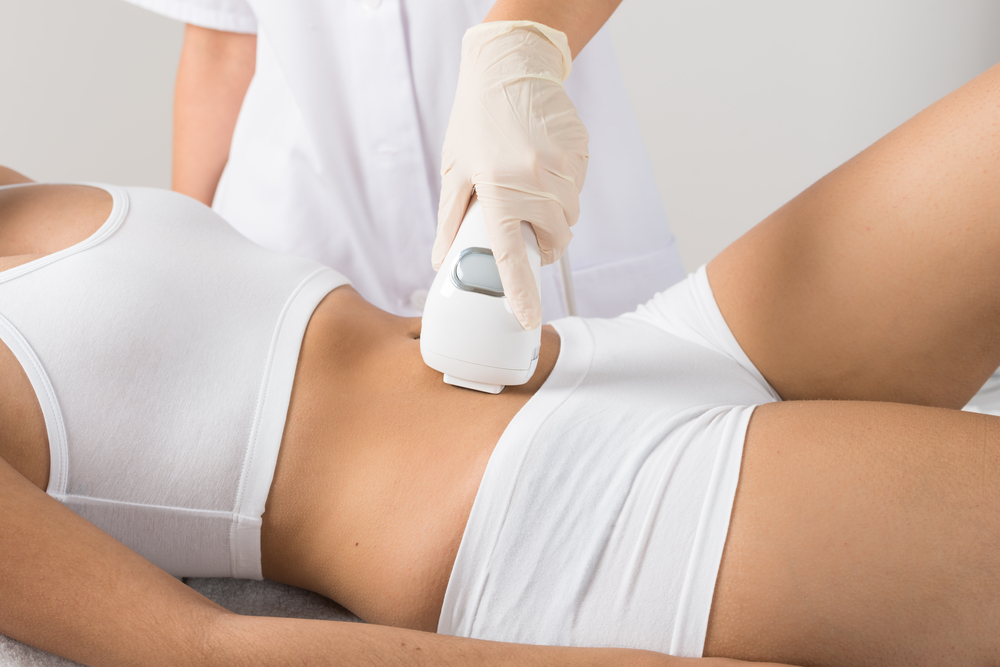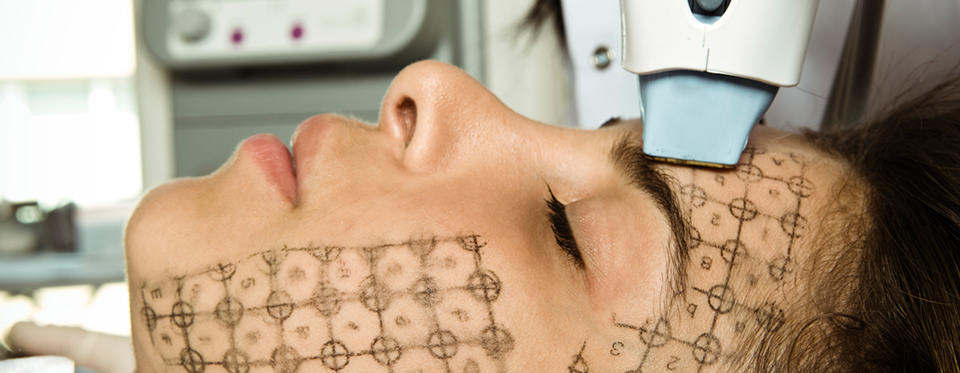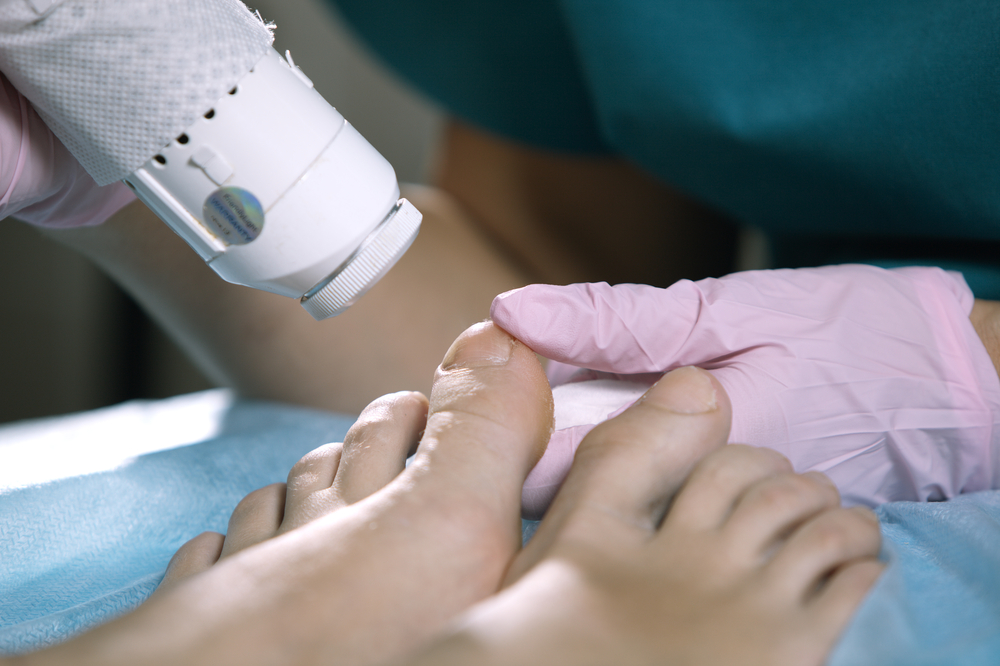No cream can magically erase stretch marks. Laser treatments remain the most effective non-surgical stretch mark treatment option.
Lasers are all the rage these days. Among numerous popular applications, they’re being used to zap away veins, tighten the skin, and eradicate unwanted hair growth. And to the delight of those living with unsightly stretch marks on their stomach, upper arms and legs, laser treatments have also proven to be highly effective.
Essentially, these lasers emit a powerful ray of light to stimulate elastin and collagen production in the targeted areas, which in turn helps to improve the skin’s appearance. It’s important to remember that while there’s still no treatment that can completely eradicate stretch marks, lasers do a great job of making them less visible.
What Causes Stretch Marks?
Also known as striae distensae, stretch marks form when the skin is continually stretched or tugged; for example, during periods of rapid weight gain or pregnancy. The middle layer of skin (the dermis) tears, which leaves the rather unsightly lower layers of the skin and blood vessels visible.
The dermis is actually designed to stretch, and has long, inter-connected fibers that are meant to accommodate growth. However, rapid growth can cause these fibers to over-stretch or break, which contributes to the formation of stretch marks.
When they first appear, stretch marks are usually red or purple due to blood vessels showing through the dermis. Later, they typically fade to a white or silvery color which may fade over time or remain visible permanently.
As annoying as they can be, these red or white marks are not uncommon. Millions of people have them, and nine out of 10 pregnant women are likely to develop them during the third trimester. Stretch marks are also common during puberty and adolescent growth spurts, and regularly arise in bodybuilders and others who tend to gain large amounts of body mass quickly.
Striae distensea can also be caused by certain medications. For example, overuse of cortisone creams has been proven to cause stretch marks because cortisone weakens the elastic fibers in the skin. Additionally, certain diseases and conditions — Cushing syndrome, Marfan syndrome and Ehlers-Danlos syndrome, for example — can affect cortisone levels and cause stretch marks.
How Does Laser Stretch Mark Removal Work?
Laser procedures come in a truly amazing variety of options. Different skin conditions can be specifically targeted using devices that produce unique wavelengths and temperatures.
For stretch mark reduction, a few laser types reign supreme, including pulsed dye, KTP, and nonablative fractional lasers (the Fraxel® laser). Although these lasers all work in a similar manner — they deeply stimulate elastin and collagen production to help minimize the appearance of stretch marks — depending on the type of stretch mark, some devices may be better suited than the others.
The KTP and pulsed dye lasers are most often recommended for treating newly formed stretch marks that are still red or purple in color. They work by stimulating collagen synthesis and destroying the damaged blood vessels that show through the stretched skin, effectively erasing deeper-colored marks without affecting the surrounding area. For best results these treatments should be started early — in the first few months post-pregnancy, for example.
Fractional non-ablative laser are best-suited for well-established stretch marks that are white or silver in color. Fraxel — the most common type of fractional lasers — boosts collagen production by shooting thousands of microscopic beams beneath the skin’s surface. Improved elasticity, texture and tone can be seen after just a few weeks, but the skin continues to improve over the following months.
How Effective Is It?
Here’s some great news for people who are looking for a good, reliable way to get rid of stretch marks; laser treatments have been proven to work. So long as you choose the right treatment plan for your unique situation, you’ll likely be pleased with the result.
Clinical studies have shown that the Fraxel® laser can reduce stretch marks by up to 75 percent after six weeks, with only one treatment per week. The pulsed dye laser has been proven to bring “measurable improvements” — a reduction in the size and depth of stretch marks, with up to a 65 percent improvement in the skin’s elasticity — in roughly 90 percent of patients.
Do Laser Treatments Hurt?
A typical laser treatment session should last between 10 and 15 minutes for areas like the tummy, upper arms and hips. Most patients report that the procedure was essentially painless and they were able to return to their normal activities immediately afterwards.
With that being said, other patients report redness for the first 24 hours or so post-treatment and itching and swelling for a few days after that. In rare instances, patients have experienced blistering, bruising, lightening or darkening of the skin color, scarring and infection.
Nevertheless, laser treatments are considered perfectly safe so long as they’re performed by a board-certified dermatologist or plastic surgeon.
How Much Does Laser Stretch Mark Removal Cost?
As with most laser treatments, with stretch marks professionals typically charge by the session. In general, most patients need between three and six treatments for optimal results.
The cost per treatment varies widely depending on which type of laser is used, your geographic location, and how many areas of the body are being treated. In general, expect to pay at least $200 per treatment. StretchMarks.org has a handy treatment calculator that you can use to get a rough estimate of the costs based on the areas being treated and where you live.
Other Options: What Works Best?
You already know that lasers are an effective treatment for getting rid of stretch marks. However, if they aren’t appropriate for you due to their high cost or potential side effects, don’t fret. Other stretch mark removal methods you may want to consider are available, although some of these are definitely more effective than others.
At-Home Laser Treatments
The very first at-home stretch mark removal device, Strialite®, came out last year. Strialite® works by emitting LED light to penetrate the skin’s outer layer and stimulate collagen. This FDA-approved option rings up for approximately $350 and should be used for 20 minutes straight twice a week. The manufacturer claims customers should begin to see results within two to six weeks.
Make sure to read a few, ideally unbiased, reviews on the device before purchasing one as there’s still a fair amount of debate surrounding the efficacy of this treatment.
Micro-Needling
The goal of micro-needling is simple: to stimulate collagen production. Using tiny, microscopic needles that are passed over the skin tissue, micro-needling devices create “micro-injuries” that naturally stimulate the growth of collagen. Of course, collagen synthesis is essential to diminishing the appearance of stretch marks, so it can be effective in treating these stubborn spots.
You can have professional micro-needling performed in an office setting or purchase an at-home device (prices range from $20 to $80) if you’d rather go with the more affordable approach.
Microdermabrasion
Because microdermabrasion deeply exfoliates the outermost layer of the skin and effectively encourages the production of collagen and elastin, it can seem like a good option for treating stretch marks. However, doctors don’t typically recommend microdermabrasion for stretch marks because the treatment doesn’t generally penetrate the layers of the skin deeply enough to get rid of them.
It’s still possible to use the method to eradicate stretch marks, mind you, but it comes with a hefty time and financial commitment. For example, one study showed microdermabrasion worked to eliminate stretch marks with aggressive treatments of five sessions a week over a period of 12 weeks.
Topical Creams
You’ve probably seen all sorts of creams, serums and potions that claim to remove stretch marks topically. Topical stretch mark solutions that contain Tretinoin — a prescription-strength vitamin A complex — are proven to have a somewhat positive effect on stretch marks, with studies showing an improvement of approximately 20 percent. The primary downfall of this treatment option is that it can’t be used by pregnant or breastfeeding women.
Hydrating the skin with cocoa butter, vitamin E or a stretch mark specific cream may help smooth and soften the skin (which theoretically makes stretch marks less visible) but they generally won’t penetrate deeply enough to make a significant improvement.
Plastic Surgery
Some stretch marks can be eliminated through surgical procedures like a tummy tuck. Unfortunately, these procedures aren’t designed to target the entirety of the stretch mark, and will only target the portion that exists on the skin tissue being removed during the procedure. Similarly, liposuction may help stretch marks appear less visible, but will not get rid of them.









